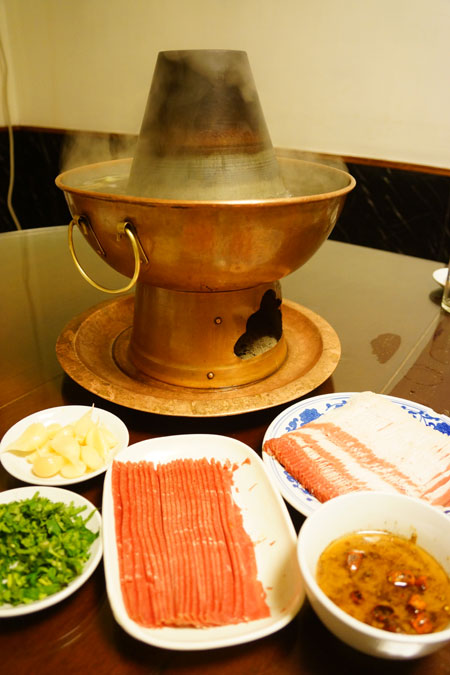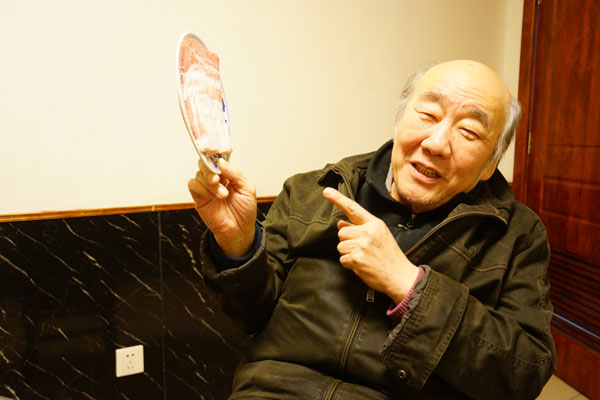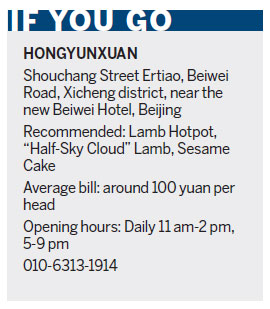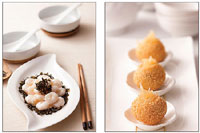Flavor to savor
 |
|
Above: A typical Beijing-style bronze lamb hotpot is served at Muslim restaurant Hongyunxuan. Photos by Ye Jun / China Daily Below: Hong Dacai demonstrates how lamb slices should stick on the plate, even if it is held vertically, as it denotes good quality meat. |

Traditional Beijing lamb hotpots and grilled meats are great dishes, reporter Ye Jun says, especially during the winter months.

Eating lamb during Beijing's bitter winter is a 200-year-old tradition and a guaranteed way of beating the freeze. Hong Dacai, the owner of Muslim restaurant Hongyunxuan, claims Mongolian and Manchu aristocrats used to favor lamb hotpot during the cold season.
"If you look at the shape of a typical Beijing-style bronze pot, with the lid on, it looks exactly like a Mongolian yurt," he says. "When you open the lid, the pot looks similar to the hat Mongolian singers wear."
Marco Polo recorded eating Mongolian hotpot at Genghis Khan's palace and Hong speculates that it was not the rinsed or instant boiled style of lamb hotpot, but boiled lamb chops.
"That was 800 years ago. But if you visit Inner Mongolia, you won't find any of the bronze Beijing hotpots. Why? Because lamb hotpot was only for nobles."
The same was true for Manchu people, who brought lamb hotpot from Northeast China to Beijing. It was only 240 years ago, when Emperor Qianlong held a banquet for 1,000 retainers, that lamb hotpot became popular.
"It was Heshen, Qianlong's court official, who figured out that hotpot would avoid the problem of big banquets, namely being able to serve up hot food, " Hong says.
|
 |
So, while Mongolians invented boiled lamb hotpot, and the Manchu brought it to Beijing, it was Muslims in Beijing who made the noble dish available to ordinary people.
Hong says the invention of lamb cutting machines in the late 1970s liberated lamb hotpot from out of the hands of Muslims in Beijing, after which it spread all over China.
The 65-year-old Hong says there are few rules for eating lamb hotpot nowadays. He prepares eight sauces instead of the usual seven. The extra sauce is yellow rice wine, which he claims was used in the old days.
Hong sees himself as a guardian of traditional lamb hotpot. He stresses the hotpot soup must be clear and have no foam on the top even after the lamb slices are added.
He insists the plates serving the lamb slices must be dry, and the lamb slices should stick on the plate, even if it is held vertically, as this is a sign of good quality.
Elsewhere, lamb hotpot now has Sichuan, Hong Kong and other variations. Meanwhile, lamb is also on the menu grilled, and is best enjoyed with friends and a couple of beers.
Kaorou Ji has an ancient style grill covered that is 1 meter in diameter and heated with fruitwood; while at Ninety-Nine Yurts Restaurant you can enjoy a hearty meal of lamb, goat and camel.
Another option is Bear Grilled Lamb Leg Restaurant, which is famed for its tender grilled lamb leg.
Fortunately, one can eat lamb the traditional Beijing way when the snow flies, sitting around glowing charcoal fires and shiny bronze pots.
It makes winter worth it.
Contact the writer at yejun@chinadaily.com.cn.
















